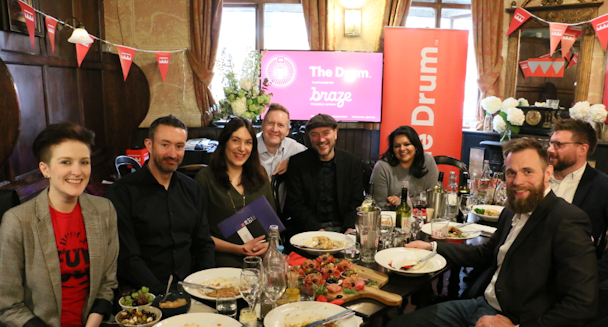Can brand humanity thrive in the era of data and tech?
As technology and data become more central in our daily lives, consumers are expecting more out of brands than ever before. They’re expecting personal, helpful, relevant messages; and tech giants like Google and Apple are making moves to ensure that brands step up with advancements in notification controls and Screen Time analysis. Brands that rise to the challenge will see the fruits of the labor through their customers’ engagement and loyalty. Those that don’t will ultimately be left behind.

Can brand humanity thrive in the era of data and tech?
At the most recent instance of The Drum Arms pop-up pub in London, Braze — the customer engagement platform dedicated to humanizing relationships between customers and brands—sponsored a roundtable with industry experts from The Guardian, Virgin, Unruly, and TSB. In their discussion, these experts explored the concept of brand humanity and how to unlock the emotional and functional attributes that build truly lasting, loyal customer relationships. The roundtable discussion was moderated by The Drum co-founder and editor-in-chief, Gordon Young.
You can download The Braze Brand Humanity Index by completing the form above.
Digital-age disruption
In October 2018, Braze commissioned research, conducted by Forrester Consulting, which they call The Braze Brand Humanity Index. This research identifies the attributes that make a brand feel human to consumers, and assesses the business impact of exhibiting that brand humanity.
So how do brands maintain a human touch in this age of technology? It seems, in fact, that technology is the key to achieving brand humanity at scale. Peter Markey, chief marketing officer at TSB says that it’s all about understanding your customers and your brand.
“Know your brand, know your customer, know what you are about, and then use technology to help facilitate that. But don't be distracted by it—see it as an enabler to fulfill your purpose and help your customers.”
There are some big decisions in life like buying a house—these experiences can be streamlined using technology, but it’s important to recognize the extent of the role technology should play. Sometimes it takes human interaction to gain the confidence needed to make those types of decisions, Markey added. “Yes, the technology can do it, but is there a need, do people want it? Alexa is great for telling you jokes and playing songs, saying random things when you're watching TV, but you don't want Alexa to read out your home insurance terms and conditions.”

Maintaining the human touch
Brands have the ability to demonstrate humanity through core emotional and functional attributes. The Braze Brand Humanity Index finds that emotional indicators provided some of the strongest drivers to consumers’ perception that a brand was dealing with them in a human way. Attributes that were the strongest predictors of whether consumers perceived brands as “human” included “responsive,” “friendly,” and “thoughtful,” among others. At the bottom of the list, or the weakest predictors, were more superficial terms like “fun,” “quirky,” and “surprising.”
With emerging channels like the connected home, there are more avenues than ever to connect with your customers using technology, suggested Nicola Spooner, vice president of brand strategy, Unruly. However, for Spooner, the principles are still the same. “Having emotional intelligence in those environments more than ever becomes paramount. Making sure that whatever tone of voice your brand owns is consistent across all the channels that you use, is really key. Anything that stands out as being unusual, different, inauthentic is completely going to discredit whatever amazing skill or experience you might have built for your customers.”

Setting the tone
The key to making the most of your technology is understanding the tools and channels available to you, and then planning your strategy around what's right for the message and channel you're using, advised Sonia Sudhakar, consumer marketing director, The Guardian.
“You don't have to personalise everything. Like a travel service disruption, do you need to personalise that? Or do you need to put in a tone of voice? [We’re in a] world between art and science—a place [where] sometimes the best thing is when the science enables the art and not just the science taking over.”
It’s all about setting the right tone for your brand, added Gaelle Comte, marketing director group loyalty, Virgin. It’s OK to be quirky, but only if it’s a good fit for your message. “One of our sister companies was experimenting with voice updates through Echo. The opening line was 'Hello Gorgeous.” The thing was, it's nice and quirky, but if you're getting a travel disruption update and it starts with that, it's not the right message. Being human is also responding to the situation. If you were in front of someone who is really hacked, you're not going to be playful and quirky.”
Brands put so much time, money and effort into their definition of brand voice, says Dan Head, chief revenue officer at Braze. “It has to be beyond being quirky. Within the emotional lever, there's tone of voice, helpfulness. Brand teams need to start being a bit more deliberate in those categories. There [must be an] effort to truly understand [what goes into] the conversation and human connection.”

Breaking down the silos
We’ve got more mobile channels at our disposal than ever before, adds Head. From news feed, to push notifications, to email—and when we’re reaching people on their mobile devices, we’re reaching them somewhere really personal. That’s why it’s important to understand how and when and how frequently we’re communicating with people on their devices. Are we adding value? Or are we bombarding them with useless information? When your teams and technology don’t communicate with one another, you risk the latter. “A lot of what we're talking about is silos in the way people approach different channels. Brands need to embrace mobile and smart devices, voice, etc. If you break those silos up, it can work very well.”
What does breaking down silos mean? In short, it means looking at all of your channels as a part of one cohesive strategy rather than individual campaign streams and having access to data that allows you to constantly iterate on that strategy. When you’re able to do this successfully, it gives your teams the freedom and information they need to start working human empathy into their campaigns.
Listen to your consumers
“We looked at a number of [emotional and functional] levers,” explained Braze general manager, EMEA and vice president of customer success, EMEA and APAC, James Manderson. “Levers that were about not just understanding and responding to what we know about a consumer in an effective way, but also thinking about speaking to consumers in a way that is convenient to them.”
All the best brands listen deeply to their customers, said Sudhakar, and brands need to tune into the right signals. “The thing that worries me slightly is this tsunami of data points and signals in terms of algorithmic data or programmatic data. We don't necessarily give as much credibility to the old school group or panel research, etc. Sometimes you can get lost in a whole set of behavioural data and not really understand the emotional triggers of the people.”
Matt Larrson, product director group loyalty, Virgin concluded that as brands collect data on their customers they need to show them that they not only know them, but that they care for them. He added that despite privacy concerns, as long as brands deliver some kind of value exchange, consumers will mostly be happy to hand their data over.
“Let them know the purpose you are collecting their data for, that you are using it to get to know them in a way that's relevant for your brand and your product and that you’re giving something back to them. Don't be scared to use technology to deploy at scale but show them that you know them.”
You can download the Braze Brand Humanity Index by completing the form above.
Roundtable attendees:
Sonia Sudhakar, consumer marketing director, The Guardian
Gaelle Comte, marketing director group Loyalty, Virgin
Matt Larrson, product director group Loyalty, Virgin
Nicola Spooner, VP of brand strategy, Unruly
Peter Markey, chief marketing officer, TSB
Daniel Head, chief revenue officer, Braze
James Manderson, GM, EMEA & VP customer success, EMEA & APAC, Braze
Gordon Young, co-founder and editor-in-chief, The Drum
Content created with:

Braze
Braze is the customer engagement platform for leading brands. We unite data, technology, and teams to create brilliant messaging experiences.
Find out more
